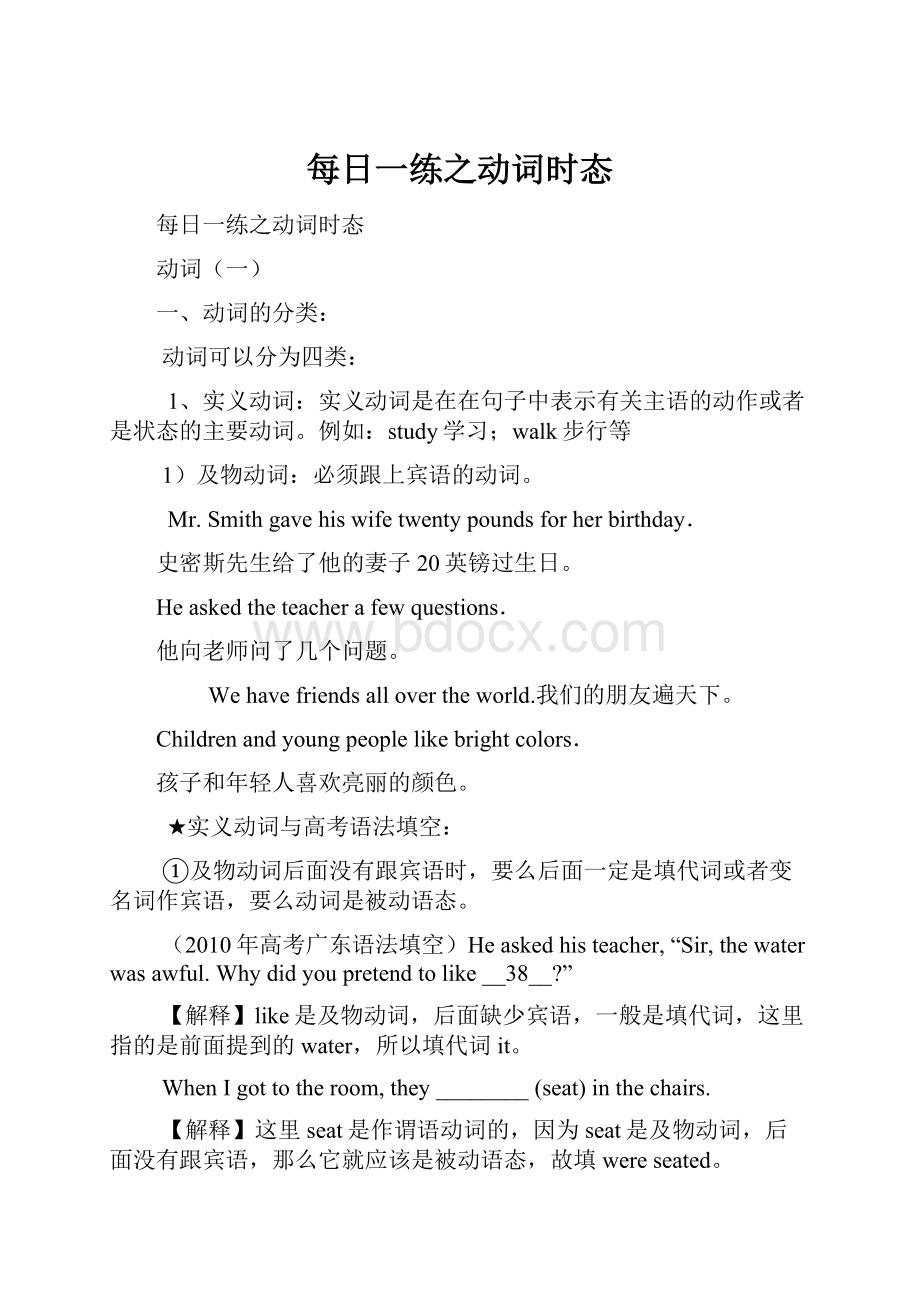每日一练之动词时态.docx
《每日一练之动词时态.docx》由会员分享,可在线阅读,更多相关《每日一练之动词时态.docx(67页珍藏版)》请在冰豆网上搜索。

每日一练之动词时态
每日一练之动词时态
动词
(一)
一、动词的分类:
动词可以分为四类:
1、实义动词:
实义动词是在在句子中表示有关主语的动作或者是状态的主要动词。
例如:
study学习;walk步行等
1)及物动词:
必须跟上宾语的动词。
Mr.Smithgavehiswifetwentypoundsforherbirthday.
史密斯先生给了他的妻子20英镑过生日。
Heaskedtheteacherafewquestions.
他向老师问了几个问题。
Wehavefriendsallovertheworld.我们的朋友遍天下。
Childrenandyoungpeoplelikebrightcolors.
孩子和年轻人喜欢亮丽的颜色。
★实义动词与高考语法填空:
①及物动词后面没有跟宾语时,要么后面一定是填代词或者变名词作宾语,要么动词是被动语态。
(2010年高考广东语法填空)Heaskedhisteacher,“Sir,thewaterwasawful.Whydidyoupretendtolike__38__?
”
【解释】like是及物动词,后面缺少宾语,一般是填代词,这里指的是前面提到的water,所以填代词it。
WhenIgottotheroom,they________(seat)inthechairs.
【解释】这里seat是作谓语动词的,因为seat是及物动词,后面没有跟宾语,那么它就应该是被动语态,故填wereseated。
②如果及物动词后面没有跟宾语,又是一个疑问句,那么前面一般填介词what。
______canIdotohelpyouwithyourhomework?
【解释】do是及物动词,后面没有跟宾语,动词也没有用被动语态,那么这里就是一个what引导的疑问句,故填What。
2)不及物动词:
不能跟宾语的动词
MostshopsinBritainopenat9:
00a.m.andcloseat5:
00or5:
30intheevening.英国大部分商店九点开门,晚五点或五点半关门。
George’sfatherlivesthere.乔治的爸爸住在那里。
Theexaminationendedat11:
30a.m.考试上午十一点半结束。
3)既可作及物又可作不及物的动词
英语动词很多既是及物动词又是不及物动词,如:
close,begin,study,leave,work等。
Thepostofficeclosesat9:
00p.m.邮局晚上9点关门。
Closethewindow,please.请关窗。
Shallwebeginnow?
我们现在开始吗?
Billbeganworkingasasailorafterheleftschool.比尔毕业后当水手。
★这种动词如果用主动语态和被动语态均可以的情况下,一般主动语态强调事物的性质,被动语态强调人为的动作。
Thedoorwon’tclose.这扇门关不了。
Thedoorwon’tbeclosed.这扇门不会被关上。
★少部分这类动词主动表示动作,被动表示状态:
preparetodosth准备做某事
bepreparedtodosth准备好了做某事
hidein在某地躲藏
behiddenin在某地藏好了
determinetodosth决定做某事
bedeterminedtodosth决定了做某事
2、联系动词:
作为系动词,它本身有词义,但不能单独用作谓语,后边必须跟表语,亦称补语,构成系表结构说明主语的状况、性质、特征等情况。
表语一般是名词、形容词、介词短语或者句子。
常见的联系动词分类是:
1)“是”类系动词:
be,remain,stay,prove,turnout
2)“起来”类系动词:
seem(似乎、看起来),look,appear,sound,taste,feel,smell。
3)“变化”类动词:
turn,become,go,grow。
Hewillsurelybecomeanengineeroneday.
Thenewly-inventedsoftdrinkingtastesquiteunique.(这种新研制的软饮料尝起来挺独特的。
Youwillremainintroubleifyoudon’ttakeanyaction.
★联系动词与高考语法填空:
①联系动词后面一般是变形容词:
Asastudent,hefelt_______(pride)tobethechairmanoftheStudent’sUnion.
felt是联系动词,后面一般变形容词,表示“自豪的”,故填proud。
②联系动词后面也可能变名词,但却表示“某人是(变成)什么”之意。
Iamsureyouwillturn_________(teach)oneday.
turn是“变成”之意,是系动词,这里是表示“变成老师”,所以变名词,填teacher。
③联系动词是没有被动语态的,所以一些联系动词需要认真判断它们的语态,易混淆的联系动词有:
“起来”类动词以及prove(后来被证明是)、turnout(后来被发现是)。
Thedishwehadjustnow______(taste)good.
Taste这个动词后面是形容词good,说明是系动词,系动词没有没打语态,这里是过去,所以用tasted。
④联系动词除了“变化”类动词外,其它没有进行时态。
You________(look)verycoolnow.
look后面跟有形容词,所以是系动词,这里虽然有now,但系动词没有进行时态,故填look。
3、助动词:
协助主要动词构成谓语动词词组的词叫助动词(AuxiliaryVerb)。
被协助的动词称作主要动词(MainVerb)。
构成时态,语态。
助动词是语法功能词,自身没有词义,不可单独使用,它没有对应的汉译,例如:
Hedoesn'tlikeEnglish.他不喜欢英语。
(doesn’t是助动词,无词义;like是主要动词,有词义)
最常用的助动词有:
be:
帮助构成进行时、被动语态或将来时
have/has/had:
帮助构成完成时态
do/does/did:
帮助构成单个实义动词的否定式、疑问式或强调式
shall,will,should,would:
帮助构成一般将来时或过去将来时
Iwasdoingthecookingwhenthetelephonerang.
Ihaveneverseenyousohappy.
Idon’tlikeeatingpork.
IwilltellyouthenewsassoonasIgetit.
4、情态动词:
情态动词是一种本身有一定的词义,但要与动词原形及其被动语态一起使用,给谓语动词增添情态色彩,表示说话人对有关行为或事物的态度和看法,认为其可能、应该或必要等。
情态动词后面加动词原形。
★助动词和情态动词与语法填空:
句子意思完整,但动词时态语态不正确时,一般填助动词或情态动词。
He_______managetogetoverthedifficultyatthattime.
这里atthattime是过去时间,应该用一般过去时,但manage却没有用过去时态,故前面填助动词did。
练习:
一、用下列句子中括号词类的正确形式填空:
1.Tom________(prepare)fortheexam,soheseemsquiteconfidentwithit.
2.Thefoodservedlastweekend________(taste)delicious.
3.TheLeaguemembersseem________(act)indoingsuchanactivity,forthey
feelveryhappy.
4.Hans______(go)toyourhomeyesterday.
5.Althoughwedoubtedabouttheeffectoftheexperiment,it______(prove)tobethebestwecouldfind.
6.Doyouwanttobecome______(assist)inthefuture?
7.Ifit______(rain)tomorrow,wewouldhavetocancelthegame.
8.Atthisverymoment,theair______(smell)verybad.
9.Becausewe_______(hide)intheforest,wecouldhardlybefoundoutbyothers.
10.She______(dress)inredandsheseemedquiteenergetic.
二、语法填空:
A
A61-year-oldwoman___1___(save)onSaturdayeveningbyRussianrescuersafter___2___(bury)forupto127hoursinrubbleinthequake-ravagedsouthwestChina’sSichuanProvince.
LocalresidentstoldRussianrescuersthatsomeonewhowasstill___3___(live)wasundertwocollapsedresidentialbuildingsinDujiangyan,acitysoutheastoftheepicenterofMonday’searthquake.
Therescuersexploredthebuildingswithdogsandmachines.Then,theycutoutasectionofthefloor,and___4___successfullypulloutthewoman.
Thewomanwasingoodconditionandwasstill___5___(ability)tothinkclearly.She___6___stillmoveherhandsandfeetandcouldstillspeak.
Thesurvivorhadlivedonthefirstfloorofthesix-storybuilding.Andshewasburiedinthedebrisoftheconcreteceilingafterthequake.
Theunidentifiedwomanwasthefirst___7___(survive)who___8___(find)byforeignrescueteams.Atotalof237rescuersfromJapan,Russia,SouthKoreaandSingaporearecurrentlyinSichuan,aidingthedisasterreliefefforts.
TheRussianrescuersarestilltryingtosaveasecondpossiblesurvivor___9___(trap)inthedebrisofthebuilding.
Intothesixthdaysincethedevastatingearthquake,which___10___(prove)China’sworstinmorethan30years,rescuers,includingmorethan130,000troops,werestillstrugglingtopullpossiblesurvivorsfromdebrisofcollapsedhouses,schoolsandfactories.
B
Accordingtothedictionarydefinitionof“create,ordinarypeopleare___1___(create)creativeeveryday”.Tocreatemeans“tobringintobeing,tocausetoexistsomethingeachofusdoesdaily”.
Wearecreativewheneverwelookatorthinkaboutsomethinginanewway.First,thisincludes___2___(aware)ofoursurroundings.Itmeansusingallofoursensestobecome___3___(aware)ofourworld.Thismaybeas___4___(simply)asbeingawareofcolorandtexture(质地),aswellastaste,whenweplanameal.Aboveall,theabilitytonoticethingsisveryimportant,butothersmightmiss___5___.
Asecondpartofcreativityisanabilitytosee___6___(relate)amongthings.Ifwehave___7___(believe)intheexpression,“Thereisnothingnewunderthesun,thecreativityisremakingorrecombining(重组)theoldinnewways.”Forexample,we___8___dothisbyfindingamoreeffectivewaytostudyorabetterwaytoarrangeourfurniture,orwemightmakenew______(combine)ofcameralensesandfilterstocreateanunusualphotograph.
Athirdpartofcreativityisthecourageanddrivetomakeuseofournewideas,toaskforthemtoachievesomenewresults.Tothinkupanewideaisonething;toputtheideatoworkisanother.
Thesethreepartsofcreativity___10___(include)inallthegreatworksofgeniuses,buttheyarealsoincludedinmanyofourday-to-dayactivities.
答案:
一、用下列句子中括号词类的正确形式填空:
1.isprepared
2.tasted
3.active
4.did
5.proved
6.assistants
7.should
8.smells
9.werehidden
10.wasdressed
二、语法填空:
A
1.wassaved。
save是及物动词,后面没有跟宾语,所以要用被动语态,这里是
讲述过去的事情,用一般过去时。
2.beingburied。
bury是及物动词,后面没有跟宾语,所以要用被动语态,after
是介词,后面用动名词的被动式。
3.alive。
was是联系动词,后面是变形容词,这里live的形容词有三种:
live,alive,living,但live是“现场的”之意,living是“健在的”之意,都不符合题意,故填alive(活着的)。
4.did。
这里successfullypulloutthewoman句意完整,但时态不正确,应该是一般过去时,所以填助动词did。
5.able。
前面是联系动词was,后面一般变形容词。
6.could。
stillmoveherhandsandfeet时态不正确,所以要填助动词或情态动词,根据后面是could,那么这里也是手脚“能”动,所以填could。
7.survivor。
was是联系动词,后面是表示“第一个被发现的幸存者”,所以变名词,故填survivor。
8.hadbeenfound。
动词find是及物动词,后面没有跟宾语,所以用被动语态,这里表示过去之前的动作,用过去完成时的被动。
9.trapped。
这里是非谓语动词作定语修饰前面的名词survivor,trap是及物动词,没有跟宾语,用被动,已经完成的被动用过去分词。
10.proved。
这里是“后来被证明是”的意思,不用被动,直接用主动的过去时态。
B
1.creative。
are是系动词,后面一般变形容词。
2.awareness。
include是及物动词,及物动词后要跟名词。
3.aware。
become是系动词,后面跟形容词。
4.simple。
be是系动词,后面跟形容词。
5.it。
miss是及物动词,后面一般填代词,这里是指代前面的ability,故填it。
6.relationships。
see是及物动词,后面变名词。
7.belief。
have是及物动词,后面要求变名词。
8.might。
dothisbyfindingamoreeffectivewaytostudy句意完整,但根据后面一个并列句orwemightmake可知这里是表示可能性,故填情态动词might。
9.combinations。
make是及物动词,后面变名词。
10.areincluded。
include是及物动词,后面没有跟宾语,所以要变为被动语态。
动词
(二)
二、动词的时态:
主动语态
一般现在时
am/are/is;do/does
一般过去时
was/were;did
一般将来时
willdo;
am/are/isgoingtodo
现在进行时
am/are/isdoing
过去进行时
was/weredoing
将来进行时
willbedoing
现在完成时
have/hasdone
过去完成时
haddone
将来完成时
willhavedone
现在完成进行时
have/hasbeendoing
(一)一般现在时与一般将来时
一般现在时
一、用法:
1、表示现在经常发生的动作,习惯,比较常用的时间状语:
often,always,usually,onceaweek
Healwayshelps(help)mewithmyhomework.
比较:
Healwayshelped(help)mewithmyhomeworklastyear.
2、表示真理性的东西
Theearthturns(turn)aroundthesun.
Lightruns(run)fasterthansound.
3、在条件状语从句,时间状语从句中,表示将来的动作。
条件状语从句:
if;unless;
Ifyoustay(stay)latetonight,pleaseremembertoturnoffthelights.
时间状语从句:
when;while;as;before;after;since;until/till;assoonas
Whenhegets(get)tothestation,hewillcallme.
4、表示按照时间表发生的动作:
作息时间表;列车时刻表;飞机航班
Thetrainwillleave/leaves(leave)at8tomorrow.
5、在makesure、takecare、mind、Idon’tcare、Itdoesn’tmatter后面的that从句一般用一般现在时表示将来动作。
Domakesurehecomesontime.
二:
动词第三人称单数形式的变化规律:
1、大多数动词在词尾加“S”在清辅音后发音为[s],在浊辅音及元音后发音为[z]。
①stop-stops[s];make-makes[s]
②read-reads[z];play-plays[z]
2、以辅音字母加“y”结尾的,要先将“y”变为“i”,然后在加“es”读[iz]如:
fly-flies[z];carry-carries[z]
study-studies[z];worry-worries
3、以“s,x,ch,sh”结尾的,在词尾加“es”,发音为[iz]如:
teach-teaches[iz];watch-watches[iz]
4、以“o”结尾的动词,加“es”,读[z]如:
go-goes[z]do-does[z]
一般将来时
1、表示将来会发生的动作或状态,一般有将来的时间状语。
He_willcome_(come)toseemetomorrow.
willdosth:
表示纯粹的将来(用于任何人称)
shalldosth:
表示纯粹的将来(用在第一人称)
am/are/isgoingtodosth:
表示“有迹象表明将要发生的动作”或“